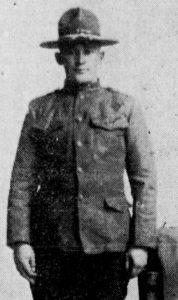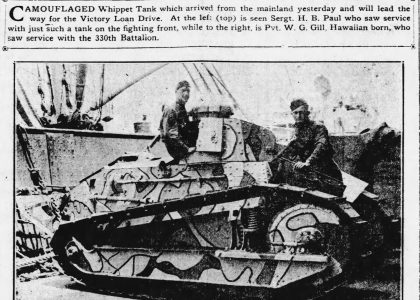
Born on September 20, 1891, in Paia, Maui, Manuel Ramos was the third child of Portuguese immigrants Manuel Ramos Sr. and Mary Ramos. His parents had arrived in Hawaii from Portugal around 1890 to work for the Maui Agricultural Company. After his father died in approximately 1902, the family remained in Paia, with Mary later marrying John Martins.
Manuel spent several formative years in California, working as a steam plow driver and later as an engineer on a steam pump. By 1917, he had relocated to Chualar, California, where he registered for the World War I draft while employed by the Spreckels Sugar Company.
Compelled by duty, Ramos enlisted in the U.S. Army Engineer Corps, joining Company E, 6th Battalion of the 20th Engineers. From Camp Lewis, Washington, he wrote home to his mother on November 24, 1917, with affection and humor: “Many loves and kisses to my mother. Well, good bye, till we see each other in France. Ha! Ha!”
On December 27, Ramos and the sixth battalion moved to Camp American University in Washington D.C., which is where Ramos wrote his final letter home dated January 2, 1918, was sent from Camp American University in Washington, D.C. He described the cold, snow-covered ground and anticipated his imminent departure for Europe, remarking grimly but stoically, “From now on it’s hell, but it’s all in a life time.”

On January 27, 1918 Ramos boarded the British transport ship Tuscania, with his battalion which departed from Halifax, Canada carrying over 2,300 American troops. It was a part of a larger convoy with 13 other ships to travel across the U-boat infested North Atlantic. By dinner on February 5, the convoy reached the North Channel between Ireland and Scotland.
At 7:40 p.m. on February 5, 1918, a lone German U-boat, UB77 launched two torpedos striking the Tuscania on her starboard side near the engine room and damaging several lifeboats leaving hundreds on the sinking ship without space on the remaining lifeboats. Nearby destroyers helped rescue survivors on the sinking ship, in the water and in the drifting life boats.
By the time the Tuscania sank amid chaos and bitter cold at 9:40 p.m., at least 266 lives were lost, including that of Private Manuel Ramos. He was 28 years old.
The devastation of the sinking was profound. Bodies washed ashore, many mutilated beyond recognition. Ramos was initially buried with military honors at Kilnaughton, on the Isle of Islay in Scotland, in Grave 56. His remains were later repatriated to the United States in September 1920 aboard the Antigone.
In the wake of the disaster, Manuel’s photograph in uniform—sent home shortly before his death—was carried by his brother Gordon as a treasured keepsake. The townspeople of Paia mourned the loss deeply. Villagers in Scotland, where many of the Tuscania’s dead were interred, paid solemn tribute in the rain, honoring the Americans who had perished so far from home.
Manuel Ramos’ name is etched on the plaque outside the War Memorial Natatorium in Honolulu, a testament to his sacrifice in the Great War.
Sources:
20thEngineers.com—World War 1—6th Battalion. (n.d.). Retrieved May 11, 2025, from https://www.20thengineers.com/ww1-bn06.html
Baum, A. (Director). (2018, February 5). Dawn of the Red Arrow—Sinking of the Tuscania [Video]. https://www.dvidshub.net/video/583200/dawn-red-arrow-sinking-tuscania
Island Boy Lost when the Tuscana Went to the Bottom. (1918, February 12). Hawaii Tribune-Herald, 1.
Lone U-Boat Attacks and Sinks British Ship Bearing Our Soldiers. (1918, February 15). Hawaii Herald, 3.
Manuel Ramos, of Paia, The Maui Boy Who Went Down with the Tuscania, and his Mother. (1918, February 22). The Maui News, 8.
Manuel Ramos, Paia, Not on survivor list. (1918, February 11). Honolulu Star-Bulletin, 1.
Pvt Manuel Antony Rames (1891-1918). (n.d.). Find a Grave.Com. Retrieved May 11, 2025, from https://www.findagrave.com/memorial/57193695/manuel_antony-rames
Scotch Villagers Honor Americans Lost on Tuscana. (1918, February 13). Honolulu Star-Bulletin, 1.
The Maui Boy Who Died on Tuscania. (1918, February 15). The Maui News, 1,8.
U.S., National Cemetery Interment Control Form. (1928, 1962). Ancestry.com. https://www.ancestry.com/search/collections/2590/records/1965156?tid=13106928&pid=402672058836&ssrc=pt
U.S., World War I Draft Registration Cards, 1917-1918. (1917, June 5). Ancestry.com. https://www.ancestry.com/search/collections/6482/records/20535420?tid=13106928&pid=402672059801&ssrc=pt


